- Get link
- X
- Other Apps

The spacecraft "New Horizons" left Earth on January 19, 2006 and at a speed of 58,000 kilometers per hour went to the far corners of our solar system. In February 2007, the New Horizons received a small charge of the orbital energy of Jupiter, which dispersed it to 84,000 kilometers per hour. After that, having overcome almost 5 billion kilometers and spent 9.5 years, the probe on July 14, 2015 met with Pluto. Now the “New Horizons” is 35 astronomical units from the Earth and is heading towards the Kuiper belt. During this time, he learned a lot about Pluto and its satellites. Today we will talk about the most interesting.
Pluto tail
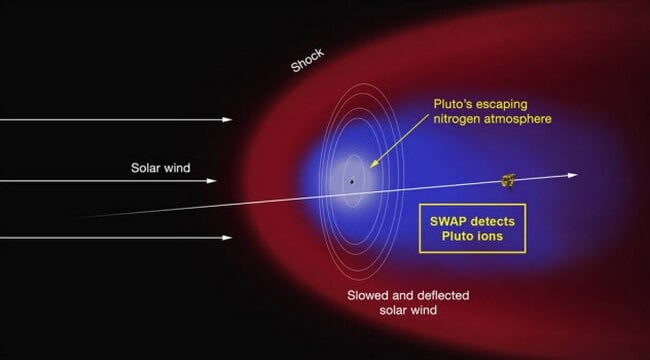
On board the spacecraft "New Horizons" the size of a piano are seven scientific instruments, including one that allows you to observe the interaction of Pluto and the solar wind blowing at a speed of 1.6 million kilometers per hour.
Thanks to this tool (called SWAP, or Solar Wind Around Pluto), the probe once again confirmed the hypothesis that Pluto, like no other planet in the solar system, has unique features associated with the influence of the solar wind on it. While small comets and other small objects simply cut through the solar wind, and other planets literally just hit it, Pluto shows both behaviors that make it look like a comet than a planet (albeit dwarf). Its nature of interaction with the solar wind is similar to the scenario characteristic of comets, according to which such interaction leads to the formation of a vast area where the solar wind is gradually slowing down - the so-called “plutopause”.
In addition, the SWAP tool determined that the dwarf planet, due to the special nature of interaction with the solar wind streams, acquired an ion tail, which stretches 77,000-110,000 beyond Pluto. The main mass of the tail are molecular ions of methane, as well as other particles that have left the atmosphere of the planet.
Unexpected surface smoothness

Having flown Pluto and having looked at it for the last time, the device "New Horizons" made pictures of its surface, covered with various shock craters. However, among the photographs was the one in which scientists noted the unexpected smoothness of the surface.
At a distance of 6 billion kilometers from the Sun, Pluto must look completely dead, like Mercury or the Moon. Its surface must be completely covered with various craters and cracks. But instead, his frozen plain Sputnik is polished almost to a mirror shine. Astronomers suggest that this region is undergoing constantly ongoing geological activity, the energy source of which is something that is under the surface of the dwarf.
Pluto Spider
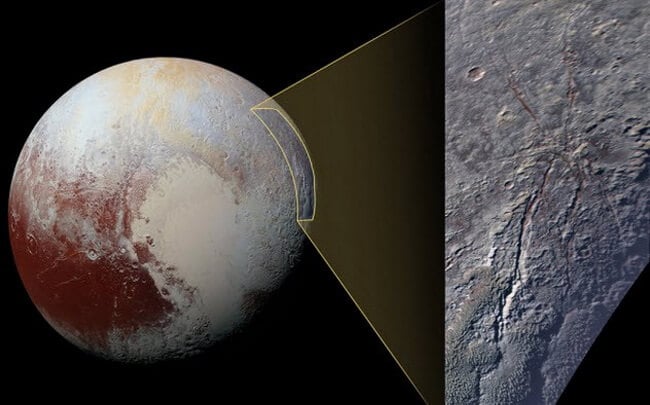
One of the surface areas of the dwarf planet is covered with cracks, which generally resemble the shape of a six-lined spider. Such a feature has never before been noted anywhere else in the solar system by scientists. The smallest "paws" have a length of about 100 kilometers, but the largest, called Sleipnir Fossa, stretches for more than 580 kilometers.
Unlike other cracks on Pluto, which are mostly parallel lines, "spider cracks" look very different. They seem to gather at one central point, which resembles a kind of cracked walnut. What is even stranger, in the depths of the cracks give a reddish tinge.
Scientists have seen something remotely similar on Mercury and Venus. Researchers believe that these cracks are the result of attempts by some underground material to burst to the surface.
Part of Pluto's atmosphere migrates to Charon
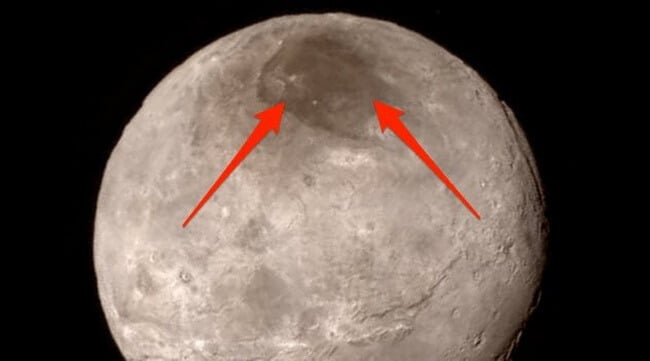
The relationship between Pluto and its moon Charon is unique. With a diameter of just 2370 kilometers, Pluto is not even half as large as its neighbor, whose diameter is about 1,200 kilometers. In addition, the satellite is very close to the planet, at a distance of about 20,000 kilometers.
The distance is close enough to allow the atmosphere to play in a kind of interplanetary frisbee. It should be noted that scientists predicted this back in the 1980s. And this behavior is characteristic of all binary pairs from planets and their satellites, as well as planets and their stars.
Forty years later, scientists finally got evidence that Charon very often “plucks” the nitrogen atmosphere of Pluto. Most of the atmospheric composition, which is attracted by Charon, just flies into space, but not all. The polar temperature of the surface varies from 60 degrees Kelvin (-213 degrees Celsius) to 15 degrees Kelvin (-258 degrees Celsius), so the attracted gas has time to freeze and freeze over the satellite.
Unknown source of nitrogen Pluto

Sunlight mixes methane and atmospheric nitrogen from Pluto into more complex hydrocarbons, which subsequently accumulate into submicrometer compounds. Collectively, this gives Pluto its slightly bluish glow.
But since the dwarf planet is too small, it is unable to hold a dense atmosphere and therefore loses it with an intensity of several hundred tons per hour. It is still unclear how Pluto has not yet lost its entire atmosphere. Perhaps this process slowed down in the long past and more recently accelerated again. There is no answer to this yet. But where does Pluto get all this nitrogen?
Most likely, nitrogen is stored on Pluto inside its frozen gut and, depending on the season, breaks out to the surface. In addition, the source (but not the main) of nitrogen can be comets, which in the distant past intensively bombarded the surface of the dwarf planet.
Pluto's heart

With the approach of the New Horizons to Pluto, it became increasingly clear that the dwarf planet has a very interesting geological feature. On its surface is a region called the Tombo region (in honor of the person who discovered it) and resembles the shape of a giant heart.
This region is surprisingly practically free of impact craters. Astronomers consider this area to be relatively young and suggest that the region has been geologically active for the last 100 million years.
The plain of Sputnik, which is located here, is generally a single collection of planetary oddities. Some areas here structure resemble cracked muddy bottom, as we have on Earth. Others, on the contrary, are very uncharacteristically hilly. The plains cut through the more obscure lines remaining on the surface, which hint that the wind is walking here and there from time to time.
Pits pluto
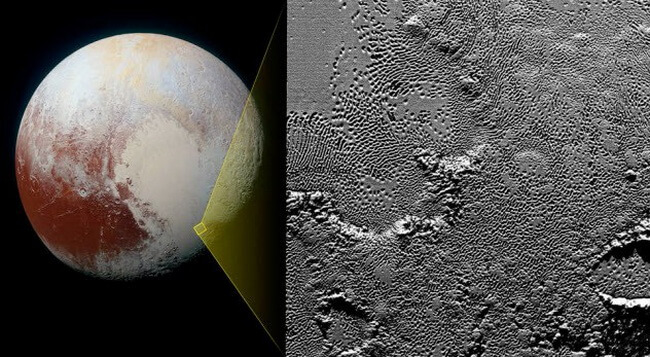
On the surface of Pluto is so cold that the matter here often misses its transition stages. For example, under the influence of the Sun, instead of melting, methane ice sublimates here going straight from solid to gaseous.
This feature creates holes on the surface of Pluto that look like holes. From the side it looks as if the dwarf planet has been bitten. This is especially noticeable in the western hemisphere, rich in its wastelands, which smoothly flow into rocky terrain. High mountains here cover methane ice, which descends to a lowland covered with water ice.
There are also grooves in the Tombo area, which remain relatively untouched by impact craters and testify to recent geological activity, very likely combinations of ice movement and evaporation. From the outside, they look small, but in fact this is a common optical illusion.
Methane snow
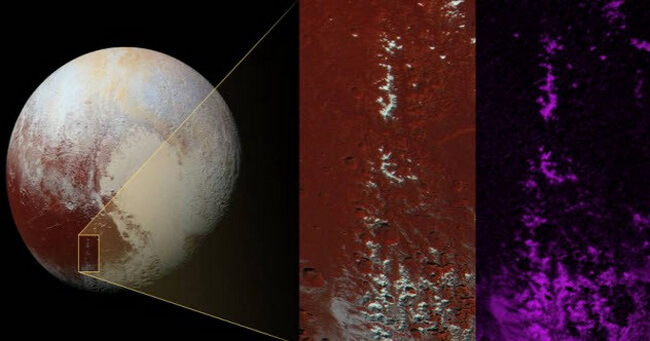
As mentioned above, Pluto is rich not only in plains, but also in mountains covered with snow and ice. One of the largest mountains is informally named Cthulhu Regio and stretches nearly 3,000 kilometers. It actually girds the surface of a dwarf planet, reaching almost half the size of its equator.
From above, the mountain looks like a collection of holes, craters, gorges and dark areas. Previously, she seemed completely inactive until New Horizons provided us with new shots of her methane snow caps.
Methane snow here stands out very noticeably against the background of darker and reddening lowlands (in the photo above, which was taken from a distance of 34,000 kilometers). Astronomers believe that snow is formed here on a similar principle that occurs on Earth.
Pluto scales
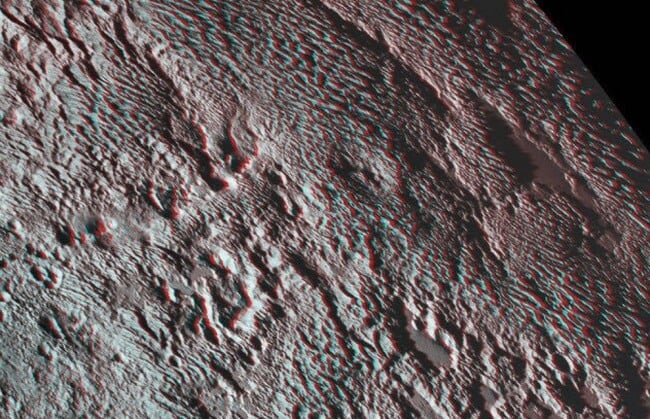
In the eastern part of the Tombo region is the Tartar mountain range, famous for its shapes and structure, resembling snake skin from afar. The only thing that is known about this area is that its “scales” are at a distance of several kilometers from each other and differ in height by several hundred kilometers. In all other respects, what scientists see here remains a mystery. It is suggested that these “scales” are deposits of methane ice or surface “scars” left over from the eruption of evaporating substances.
According to scientists, they are very strong and their basis is clathrates (a rock consisting of molecules of two substances interspersed into each other’s crystal lattice), which are formed at very low temperatures.
On Earth, clathrates usually form deep in the ocean, but they are very fragile and are easily destroyed. On the icy surface of Pluto, they create a very hard shell around frozen methane.
Walking hills of pluto
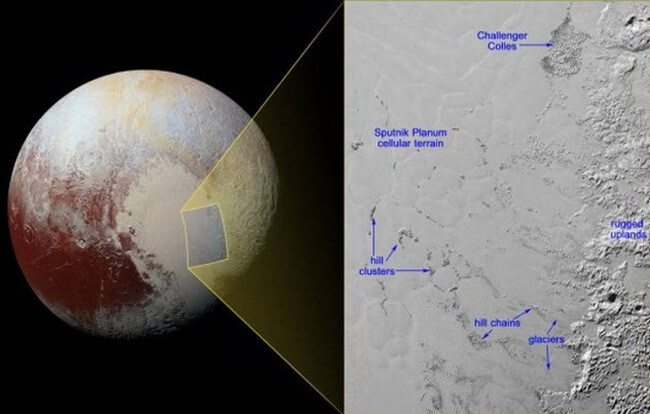
The hills of Pluto are simply amazing. They are not at all like here, on Earth, and from time to time they “migrate” across the entire surface of the Tombo area. Like icebergs, they drift across the frozen nitrogenous ice plains of Pluto.
Since nitrogen ice is less dense than water, it seems to be the ideal basis for sliding these hills. Most likely, the source of their movement is the convective forces inside Pluto. At their core, they are glaciers about 20 kilometers long, which eventually merge to form large hilly zones, the largest of which is called the Challenger Colles (named after the Shuttle Challenger crew).
Nevertheless, all these hills are only a reduced copy of Pluto’s giant icy mountains. Consisting of frozen nitrogen, methane and carbon dioxide, they reach an altitude of up to 3,500 kilometers, cutting through the lower layers of the atmosphere. Their age is at least one hundred million years old, which allows them to be considered as one of the youngest tumors in the Solar System, which also continue to grow.
The article is based on materials .
- Get link
- X
- Other Apps
Comments
Post a Comment